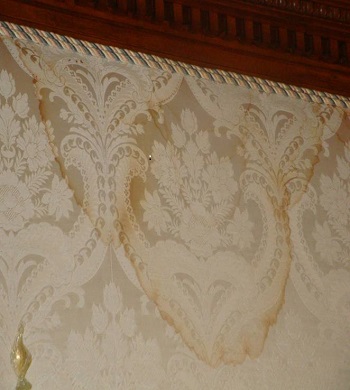Jim Pemberton
MB Exclusive.
- Joined
- Oct 7, 2006
- Messages
- 12,058
- Name
- Jim Pemberton
Four Serious Reasons To Be Cautious With Heavily Soiled Rayon! (or other heavily soiled natural fibers)
Jim Pemberton - Fabric Pro Specialist
Interior designers have developed a love affair with rayon (and its very close relative, viscose), and are now using it for both area rugs and upholstery extensively.
As a result of this powerful (and unfortunate) trend, you as a cleaner must be aware of the risks in cleaning any textile, rug or upholstery, made from this fiber.
Here are four "must recognize" problems that you will face:
1. FABRIC WEAKNESS AND SHRINKAGE:
Rayon fibers are weaker when wet, and are prone to shrinkage. You must always qualify clearly the fact that soil removal is limited by the potential of fabric damage and shrinkage. In this case, the fabric in question was already showing extensive deterioration around heavy usage areas, which means that almost any agitation at all would cause further damage.

"This rayon fabric has splits along the arm, and will likely experience more damage during cleaning"
2. DRY CLEANING LIMITATIONS:
Even though some furniture manufacturers recommend dry cleaning as the only safe method of cleaning, dry solvents cannot remove water rings or heavy soil.If the customer insists that the fabric be dry cleaned, they need to know that the rings and soil will remain after cleaning.
3. RAYON IS DIFFICULT TO CLEAN:
Even if shrinkage and fabric damage were not an issue, rayon stubbornly holds onto soil and stains. The safest products for rayon and other natural fibers are usually neutral or mildly acidic, but rarely are they able to remove heavy soils and stains. In some cases, using something with an built in oxidizing agent, such as Oxybuff Cotton Shampoo, might help, but the oxidizer might also further weaken the fibers.
4. WATER STAINS:

"Water stains may be present from spills on rayon fabrics, even if those spills only contain clear water"
Water stains often are removed by the application of distilled water. Not only is distilled water very effective in removing water stains, its also not likely to cause any other damage. If the water stains do not come out with distilled water, you can try oxidizing agents, but be aware that these might cause fabric weakness, overwhitening, or color bleeding.
************************************************
A written agreement on a upholstery condition report will limit your liability should you damage the piece, but in many cases its better to decline to clean something that you aren't confident will come clean no matter what you try, rather than to do so and damage the furniture more than it already is damaged.
Jim Pemberton - Fabric Pro Specialist
Interior designers have developed a love affair with rayon (and its very close relative, viscose), and are now using it for both area rugs and upholstery extensively.
As a result of this powerful (and unfortunate) trend, you as a cleaner must be aware of the risks in cleaning any textile, rug or upholstery, made from this fiber.
Here are four "must recognize" problems that you will face:
1. FABRIC WEAKNESS AND SHRINKAGE:
Rayon fibers are weaker when wet, and are prone to shrinkage. You must always qualify clearly the fact that soil removal is limited by the potential of fabric damage and shrinkage. In this case, the fabric in question was already showing extensive deterioration around heavy usage areas, which means that almost any agitation at all would cause further damage.

"This rayon fabric has splits along the arm, and will likely experience more damage during cleaning"
2. DRY CLEANING LIMITATIONS:
Even though some furniture manufacturers recommend dry cleaning as the only safe method of cleaning, dry solvents cannot remove water rings or heavy soil.If the customer insists that the fabric be dry cleaned, they need to know that the rings and soil will remain after cleaning.
3. RAYON IS DIFFICULT TO CLEAN:
Even if shrinkage and fabric damage were not an issue, rayon stubbornly holds onto soil and stains. The safest products for rayon and other natural fibers are usually neutral or mildly acidic, but rarely are they able to remove heavy soils and stains. In some cases, using something with an built in oxidizing agent, such as Oxybuff Cotton Shampoo, might help, but the oxidizer might also further weaken the fibers.
4. WATER STAINS:

"Water stains may be present from spills on rayon fabrics, even if those spills only contain clear water"
Water stains often are removed by the application of distilled water. Not only is distilled water very effective in removing water stains, its also not likely to cause any other damage. If the water stains do not come out with distilled water, you can try oxidizing agents, but be aware that these might cause fabric weakness, overwhitening, or color bleeding.
************************************************
A written agreement on a upholstery condition report will limit your liability should you damage the piece, but in many cases its better to decline to clean something that you aren't confident will come clean no matter what you try, rather than to do so and damage the furniture more than it already is damaged.

 ...
...

